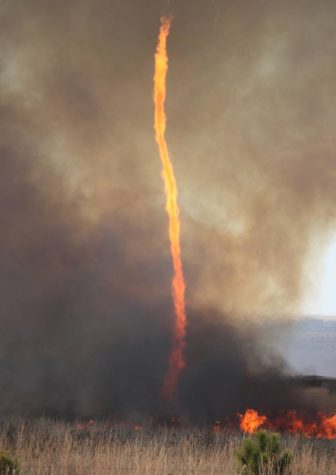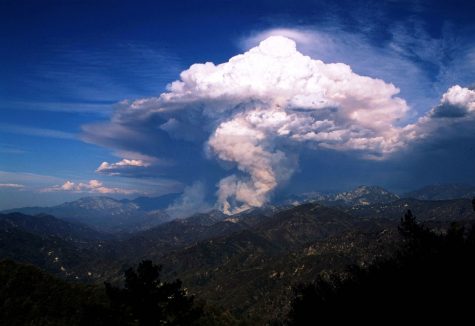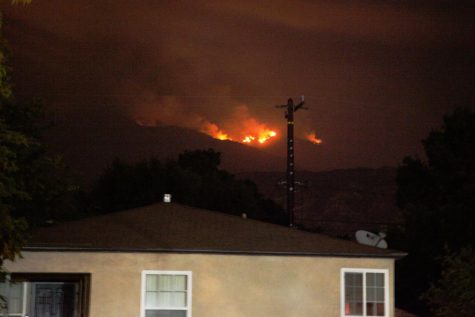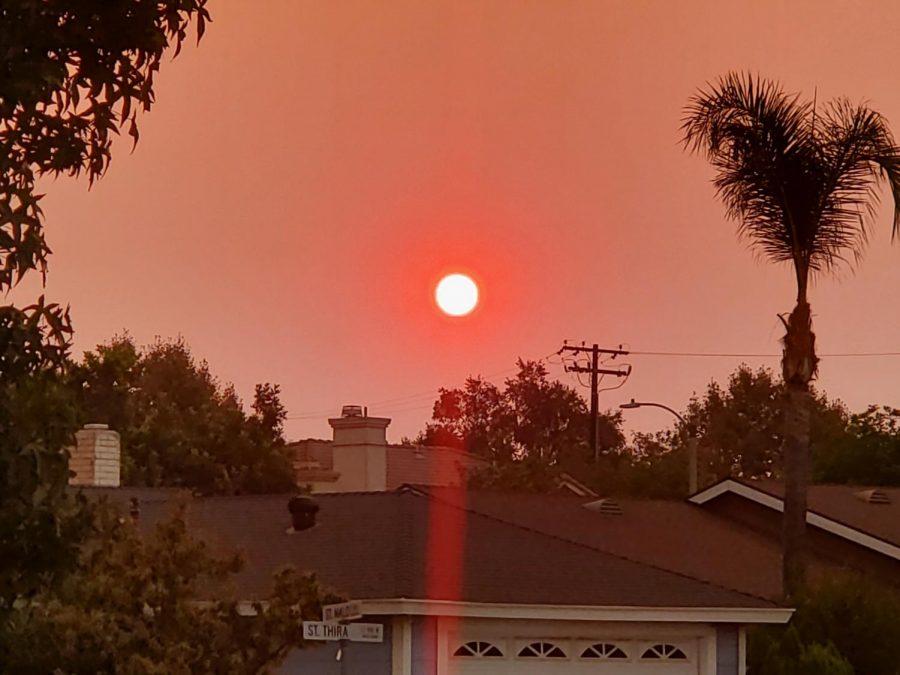What’s Causing the Red Sun?
No, the world isn’t ending, here’s what’s really happening
As fires rage across the Pacific Northwest and the San Gabriel Valley mountain ranges, ashes can be seen coating everything in sight. Other effects of the wildfires include the apocalyptic scenes of a deep red sun and a yellowish tint in the sunlight, leading some residents to panic over the strange sight.
this red sun is making me feel like we’re gonna go to war #apocalypse2020 pic.twitter.com/dsalmFogz9
— maipokes (@maipokes) September 9, 2020
“It looked like something out of “Star Wars”, I felt like I was on a different planet,” said Alex Aceves, 20, a Hacienda Heights resident who works in Covina near the fires. “I’m not sure if the cloud above us is really harmful, but yesterday I had a bunch of ashes in my nose from working outside.”
What the fuck is happening to the sun????? Anyone else see a red sun?
— Calimari (@Fresh_Calimari) September 8, 2020
Aaron Argenal, 21, an El Monte resident who lives near the fires, said that the sight of the fires moving down the mountain worry him. “It’s kind of scary. I thought we would have it under control already. It’s creeping down the mountain and scaring me and my family,” Argenal said.
The red sun for the past few days worries him.
“It’s a bit terrifying. We’re trying our best to stay inside to avoid the smoke. It’s oddly pretty but at the same time it’s scary. It reminds me of the fires in Australia with a bright red sky in the middle of the day. It makes me wonder if it gets worse what it will look like.”
But what is going on exactly? Are we really nearing the end times, or are these just natural phenomena?
According to the National Aeronautics and Space Administration, NASA, the U.S. government agency that is responsible for science and technology related to air and space, this isn’t the first time we’ve seen a red sun for the same reasons.
In 2015, fires in Siberia caused smoke which drifted across the Pacific Ocean and over the Northwestern United States in 2015. States like Oregon and Washington experienced a red sun as a result.
But how, exactly, does this happen?
Anthropology professor Dr. Frances Borella says it’s almost like a camera filter. “The smoke is just filtering out certain wavelengths of light,” Borella said.
As light travels from a source, it is made up of different wavelengths or light particles, shorter wavelengths result in blues and greens while longer wavelengths result in reds and oranges. Longer wavelengths are also stronger and can travel further through opaque atmospheres like clouds and smoke. This is why in the afternoons and mornings, when the sun is further and the light needs to pass through more atmosphere we see more deep orange and red as a result of stronger wavelengths. As the sun goes higher in the sky and the light doesn’t need to travel through so much air, we begin to see the blue sky as a result of the shorter, weaker wavelengths being able to pass through the atmosphere and reach us.
This natural phenomenon is what has been causing our red sun. Since its start on Sunday afternoon, the Bobcat Fire has been producing enough smoke to prevent the passage of shorter wavelengths from the sun, resulting in a deep red sun without any blues or greens to tone down the color.
While this is a less dangerous effect that wildfires cause, it is important to realize that they can be an incredibly destructive force. Destroying anywhere from 3 million to 10 million acres of forest and vegetation per year, the damage caused by wildfires spreads far beyond the blaze itself.
Weather forecasts this week originally reported sunny skies with temperatures soaring above 90 degrees most days. Instead, a gray sky blocks out the sun over the San Gabriel Valley and the air smells of smoke.
The clouds may be a result of a natural phenomenon called a firestorm. Although firestorms may vary, weather caused by wildfires can be as dangerous as the name sounds.

As fires grow and produce more smoke, they have the potential to produce their own weather systems. The heat from the fires can produce their own wind, clouds, rain, lightning and even fire tornadoes.
The way it works is that as fires heat up, the air above the fire rises, creating a vacuum. This causes the air around the fire to be sucked up very quickly, causing a form of wind called an updraft. In some cases, this updraft can pull flames up hundreds of feet into the air, causing a fire whirl, otherwise known as a fire tornado.
When smoke rises on these updrafts and reaches the upper atmosphere, they begin to condense. The water already present in the atmosphere as well as water that is evaporated when plants burn in the fire is then added, forming what is called a Pyrocumulus, which means “fire cloud.”
When fires are big enough, these pyrocumuli may become pyrocumulonimbi, which is a fire storm cloud. These clouds can produce lightning, which may ignite more fires. They also generate strong wind which can fan fires and cause them to burn even hotter.
Although it is a rare occurrence, pyrocumulonimbi can also cause rain, which may help in extinguishing the fires.

Air quality is also dropping because of the smoke, which can cause a wide array of health problems.
According to the EPA, the most harmful factor to consider with the fires is fine particles in the air. These can cause different health problems, as stated on the website, “from burning eyes and a runny nose to aggravated chronic heart and lung diseases. Exposure to particle pollution is even linked to premature death.”

Antonio Solorio, 21, a sign language interpretation major at Mt. SAC who lives in West Covina and has asthma, said that he’s worried about the smoke not only for him, but for other people with breathing conditions.
“If the smoke gets worse, all of us are going to suffer because of the fires,” Solorio said. “I hardly go out because of the pandemic, but now I can’t go out at all, even for a walk. My parents force me to stay inside and I need to take all the necessary precautions now.”
I, personally, am also feeling the effects of the smoke. Suffering from mild to severe allergies, I need to stay inside my house with the windows shut in order to avoid the effects of the wildfires. When I step outside without having taken any allergy medication, I immediately begin to sneeze uncontrollably. My nose gets runny and won’t stop leaking, and my eyes begin to swell up with hives and uncontrollable itching.
James Clendenen, an avid outdoorsman and a West Covina resident, said, “Ashes from poison oak can still cause itching; if you touch any of the ashes and they come from a burning poison oak plant, you’ll start to form a rash.”

The ashes can also have an effect on cars, the paint jobs specifically.
As organic material burns, the ashes they produce are made up of elements like calcium, potassium, phosphorus and magnesium.These elements are inert, meaning they have no reactive effects in their dry form. Add water, and that changes.
According to Autoservice World, there is a serious risk of chemical etching on automotive paint finishes when these elements are mixed with water.
Washing your car, leaving it out and unprotected on a foggy morning or a wet night can result in the chemical etching and causing serious damage to the paint on your car.
Elements like potassium and calcium, when combined with water, can form into chemicals like potassium hydroxide and calcium carbonate, which are both corrosive and can badly damage paint. Autoservice World reports that these chemicals can have the same corrosive characteristics as drain cleaner.
As of Sept. 11, the Bobcat Fire is only six percent contained. The estimated containment date is Oct. 15, 2020.
For up-to-date local fire coverage, follow @SAConScene on Twitter and check SAC.Media for updates.


